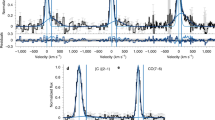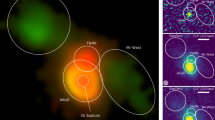Abstract
VERY remarkable and fruitful correlations have in recent years been detected, mainly at Mount Wilson, between the magnitudes of stars and their spectroscopic characteristics. The interpretation that would naturally present itself is that magnitude can enter into relation with the radiative phenomena of the surface atmosphere only through the intensity of gravity at the surface, which when great flattens down a steady atmosphere far more than proportionately. But if, following Eddington's empirical relation, total radiation of a star is a function of its mass alone, there must be more than this involved for the radius of the star persists in this relation when expressed in terms of intensities of surface radiation and of gravity, the former determining the temperature roughly by itself. Modern hypothesis, which treats confidently of an ‘electron gas’ with an atomic weight, as Ramsay boldly and prematurely proposed long ago, and subject to the Maxwell-Boltzmann exponential energy formula for statistics of distribution, and to its consequences for the theory of dissociation of mixed gases in relation to pressure and temperature, has on the initiative mainly of Saha led to promising applications to stellar atmospheres, which are held to be of densities low enough at any rate not to forbid this mode of treatment.
This is a preview of subscription content, access via your institution
Access options
Subscribe to this journal
Receive 51 print issues and online access
$199.00 per year
only $3.90 per issue
Buy this article
- Purchase on SpringerLink
- Instant access to full article PDF
Prices may be subject to local taxes which are calculated during checkout
Similar content being viewed by others
Author information
Authors and Affiliations
Rights and permissions
About this article
Cite this article
LARMOR, J. The Connexion of Mass with Luminosity for Stars. Nature 125, 273–274 (1930). https://doi.org/10.1038/125273a0
Issue date:
DOI: https://doi.org/10.1038/125273a0



